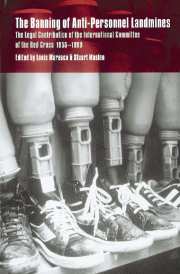 The Banning of Anti-Personnel Landmines
The Banning of Anti-Personnel Landmines Book contents
- Frontmatter
- Contents
- Foreword by Cornelio Sommaruga, President, International Committee of the Red Cross
- Foreword by Ambassador Jacob S. Selebi, South Africa
- Foreword by Ambassador Johan Molander, Sweden
- Introduction
- PART 1 FROM PRINCIPLES TO RULES: REGULATING MINES UP TO THE 1980 CONVENTION ON CERTAIN CONVENTIONAL WEAPONS
- 1 Historical background: the international law governing weapons
- 2 The ICRC's draft rules to protect civilian populations 1955–1956
- 3 Expert contributions to the Diplomatic Conference on the Reaffirmation and Development of International Humanitarian Law Applicable in Armed Conflicts 1973–1977
- 4 The United Nations Convention on Prohibitions or Restrictions on the Use of Certain Conventional Weapons Which May be Deemed to be Excessively Injurious or to Have Indiscriminate Effects, adopted 10 October 1980
- PART 2 THE REVIEW CONFERENCE OF THE 1980 CONVENTION ON CERTAIN CONVENTIONAL WEAPONS: AN INITIAL RESPONSE TO THE LANDMINE CRISIS
- PART 3 THE OTTAWA PROCESS FROM REGIONAL INITIATIVES TO AN INTERNATIONAL PROHIBITION OF ANTI-PERSONNEL MINES
- Index
4 - The United Nations Convention on Prohibitions or Restrictions on the Use of Certain Conventional Weapons Which May be Deemed to be Excessively Injurious or to Have Indiscriminate Effects, adopted 10 October 1980
from PART 1 - FROM PRINCIPLES TO RULES: REGULATING MINES UP TO THE 1980 CONVENTION ON CERTAIN CONVENTIONAL WEAPONS
Published online by Cambridge University Press: 03 December 2009
- Frontmatter
- Contents
- Foreword by Cornelio Sommaruga, President, International Committee of the Red Cross
- Foreword by Ambassador Jacob S. Selebi, South Africa
- Foreword by Ambassador Johan Molander, Sweden
- Introduction
- PART 1 FROM PRINCIPLES TO RULES: REGULATING MINES UP TO THE 1980 CONVENTION ON CERTAIN CONVENTIONAL WEAPONS
- 1 Historical background: the international law governing weapons
- 2 The ICRC's draft rules to protect civilian populations 1955–1956
- 3 Expert contributions to the Diplomatic Conference on the Reaffirmation and Development of International Humanitarian Law Applicable in Armed Conflicts 1973–1977
- 4 The United Nations Convention on Prohibitions or Restrictions on the Use of Certain Conventional Weapons Which May be Deemed to be Excessively Injurious or to Have Indiscriminate Effects, adopted 10 October 1980
- PART 2 THE REVIEW CONFERENCE OF THE 1980 CONVENTION ON CERTAIN CONVENTIONAL WEAPONS: AN INITIAL RESPONSE TO THE LANDMINE CRISIS
- PART 3 THE OTTAWA PROCESS FROM REGIONAL INITIATIVES TO AN INTERNATIONAL PROHIBITION OF ANTI-PERSONNEL MINES
- Index
Summary
The 1977 Additional Protocols to the Geneva Conventions of 1949 do not include prohibitions or restrictions on specific conventional weapons. None the less, the conference which negotiated and adopted the treaties, the Diplomatic Conference on the Reaffirmation and Development of International Humanitarian Law 1974–1977, recommended that a separate meeting be held to consider restrictions on conventional weapons which might be considered to be excessively injurious or have indiscriminate effects. This recommendation was subsequently endorsed by the United Nations General Assembly. Following two preparatory meetings, a United Nations Conference was convened in Geneva from 10 to 28 September 1979 and from 15 September to 10 October 1980 and adopted the United Nations Convention on Prohibitions or Restrictions on the Use of Certain Conventional Weapons Which May be Deemed to be Excessively Injurious or to Have Indiscriminate Effects. This convention, which was adopted 10 October 1980, is also known as the Convention on Certain Conventional Weapons (CCW or 1980 CCW).
The 1980 CCW contains a framework convention and three annexed protocols each regulating or prohibiting specific types of weapons. Protocol I prohibits the use of weapons which injure by means of fragments not detectable by X-rays. Protocol II governs the use of mines, booby-traps and other similar devices. Protocol III limits the use of incendiary weapons.
Protocol II regulates both anti-personnel and anti-vehicle mines. It prohibits their indiscriminate use and their manual emplacement in populated areas unless combat is taking place or is imminent or the mined areas are clearly marked. Remotely delivered mines are prohibited unless they are used in the vicinity of a military objective and their location can be accurately recorded or they possess an effective neutralizing mechanism.
- Type
- Chapter
- Information
- The Banning of Anti-Personnel LandminesThe Legal Contribution of the International Committee of the Red Cross 1955–1999, pp. 90 - 124Publisher: Cambridge University PressPrint publication year: 2000


